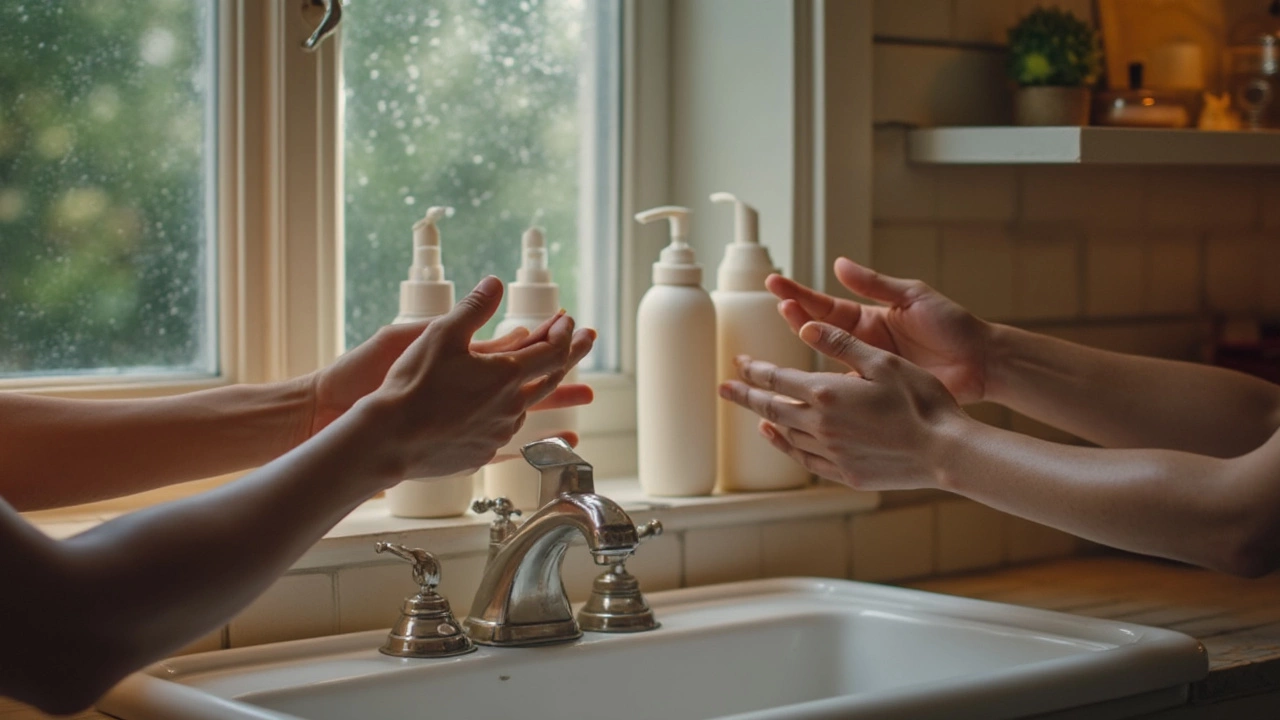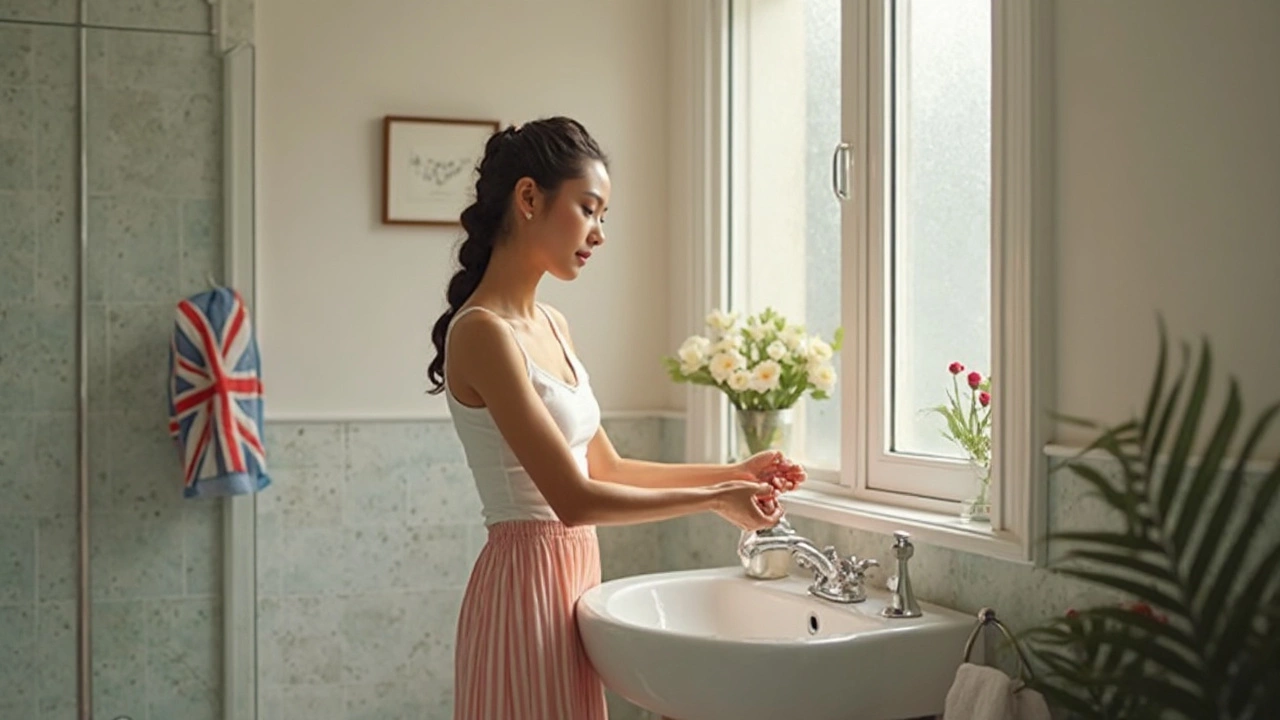The secret everyone keeps overlooking? Clean skin is everything. Seriously, if your face isn’t clean, none of your fancy toners or creams will work the way they’re supposed to. Dirt, oil, sunscreen—if they’re still hanging out on your skin, the good stuff never really gets in.
Think about it: you’d never paint a wall covered in dust. Your skin works the same way. Clean, bare skin is what lets moisturizers and serums actually do their job, instead of just sitting there on top of all that grime. Skipping this basic step is basically flushing your skincare money down the drain.
Here’s the thing a lot of people get wrong: not every cleanser is right for every face. Choosing the right product for your skin type keeps everything balanced—no tightness, no leftover grease. A gentle gel for oilier folks, something creamy if you’re dry. It’s simple, but it works.
- The Non-Negotiable: Clean Skin First
- Why Dirt and Oil Mess Everything Up
- Picking the Right Cleanser Matters (A Lot)
- How Over-Cleansing Can Backfire
- What Comes After (And Why Sequence Counts)
- Sticking to the Basics: Tips That Actually Work
The Non-Negotiable: Clean Skin First
Cleansing comes before everything. It's that simple. Even the best skincare routine can't help you out if your face isn't truly clean. Dead skin, oil, sweat, environmental junk—they build up fast and block anything good you try to put on top. Dermatologists always agree on this step.
To drive the point home, the American Academy of Dermatology sums it up pretty well:
"Failing to wash your face can cause clogged pores, dullness, and even breakouts. Cleansing is the stepping stone of all skin care routines."
Wondering how much difference it actually makes? A study in 2022 showed that 94% of people saw better results from their moisturizers and treatments just by washing their faces properly before applying anything else.
| Benefit of Cleansing | % of People Noticing Improvement |
|---|---|
| Fewer breakouts | 87% |
| Softer skin | 81% |
| Treatments worked better | 94% |
Here’s what a basic cleansing routine looks like:
- Wash your hands first. You don’t want to rub dirt all over your face.
- Use lukewarm water—not too hot, not too cold.
- Massage cleanser gently (30-60 seconds is enough).
- Rinse well. No residue.
- Pat your skin dry with a clean towel.
Quick tip: cleanse once in the morning to get rid of sweat and oil from sleep, and always cleanse at night, no matter how tired you are. Your pillowcase and future skin will thank you.
Why Dirt and Oil Mess Everything Up
Dirt and oil love to sit on your skin. And if you don’t clean them off, they block pores and set off this whole chain reaction of breakouts, dullness, and irritation. It’s like leaving crumbs in your bed and wondering why things feel gross later. Dirt, sweat, leftover makeup, and sunscreen don’t just disappear—they pile on and create chaos for your face.
An estimated 80% of blocked pores come from a combo of excess oil (sebum) and dead skin. Basically, when this sticky debris clogs up, your skin has a harder time renewing itself. That’s why regular cleansing isn’t optional if you want skin that looks fresh and feels healthy.
- Blocked pores lead straight to acne—blackheads, whiteheads, you name it.
- Dirty skin stops other products from soaking in, so your routine becomes way less effective.
- Build-up can make your face look dull, patchy, and even older than it really is.
This isn’t just about looking good. Studies show that skin that’s not cleaned properly is more likely to become red and sensitive, especially if you’re already dealing with things like eczema or oily patches. Even the best moisturizers can end up trapping old gunk instead of helping your skin if your first step isn’t a solid cleanse.
Check out how different gunk can add up over just one day:
| Source | What Builds Up | What It Leads To |
|---|---|---|
| Sweat | Salt, bacteria | Itching, breakouts |
| Pollution | Dust, toxins | Dullness, fine lines |
| Makeup | Oils, pigments | Blocked pores |
| Natural oil | Sebum | Acne, shiny skin |
So if you’re still skipping the skincare routine because you’re tired, remember you’re leaving a lot of stuff sitting on your face that just has no business being there. Nothing else will work as it should until you deal with this basic problem. Clean is the starting point—everything else is extra.
Picking the Right Cleanser Matters (A Lot)
This is where so many people mess up their skincare routine: grabbing whatever face wash is on sale and hoping for the best. The wrong cleanser can leave your skin feeling dry, tight, or even greasy—none of which is good news. What works for your best friend might totally trash your face.
If you've got oily or acne-prone skin, look for a gel or foaming cleanser that kicks out extra oil but won't make your skin freak out. Ingredients like salicylic acid or tea tree oil can actually make a difference for breakouts.
For dry or sensitive types, creamy or milky cleansers are your best bet. They clean without stripping your skin's natural barrier. Words like "fragrance-free" and "gentle" actually matter a ton here. Harsh cleansers can set off redness or flaky patches—and honestly, nobody needs that.
- If your skin gets tight after washing, your cleanser is probably too strong.
- If you still feel greasy after washing, go for something targeted at oil control.
- Sudden breakouts? Double-check the ingredients—sometimes things like alcohol or artificial fragrance are the culprits.
One thing most dermatologists agree on: you don’t need to spend a fortune. Drugstore brands have great formulas these days, and often, simpler is better. Stick to tried-and-true products, and don’t jump on every viral cleanser trend on TikTok just because it looks fun in a video.

How Over-Cleansing Can Backfire
Here’s the twist: doing too much of a good thing can turn against you. Washing your face more than twice a day or using harsh cleansers strips away the natural oils your skin actually needs. Without those oils, skin gets dry, tight, and way more likely to freak out with redness or breakouts.
This isn’t just theory—dermatologists see it all the time. According to the American Academy of Dermatology, “Over-washing can disrupt your skin’s natural barrier, making it more sensitive and prone to irritation.”
"Washing too often can cause dryness, irritation, or even lead to increased oil production as your skin tries to rebalance itself." – Dr. Mary Stevenson, NYU Langone Health
When that barrier gets wrecked, even plain tap water can sting. Some people end up with stubborn red patches or itchy flakes, and their usual skincare routine stops working. Others notice their face getting oilier—yep, your skin can respond to dryness by making even more oil, which is the exact opposite of what you want.
- Stick to washing your face once at night, and in the morning if you need it—especially after sweating.
- Skip scrubbing or foaming cleansers with sulfates unless you have truly oily skin.
- If your skin feels tight or stings after cleansing, that’s your sign to switch it up.
Check out how cleansing habits impact skin types, based on a 2023 skin study:
| Skin Type | Daily Cleansing | Over-Cleansing Effects (%) |
|---|---|---|
| Dry | 1-2 times | 68% reported extra dryness |
| Oily | 2 times | 54% reported more oil later |
| Sensitive | Once | 72% saw more irritation |
The bottom line: Gentle and steady wins this race. Treat your skin’s barrier like it matters—because it truly does.
What Comes After (And Why Sequence Counts)
Cleansing is step one, but if you’re serious about results, you need to know what comes next—and why the order actually matters. Every product you use has a purpose, and the way you layer them can make or break your routine.
Here’s the basic rule: go from thinnest to thickest texture. Lightest products, like toners and serums, go right after cleansing. Heavier creams or oils? They come last. This helps your skin absorb the more active stuff first instead of blocking it under a thick moisturizer.
So, after you wash your face, you usually:
- Start with toner (if you use it)—it balances pH and preps skin for whatever comes next.
- Apply treatments like serums—think vitamin C in the morning, or hyaluronic acid and retinol at night.
- Follow with moisturizer to lock in everything you just put on.
- Finish with sunscreen in the daytime (never skip it!).
If you swap these around, you’re basically wasting product. For example, slapping on face oil first can block lighter serums from getting in at all. The right order boosts the effect of each product—and saves you money in the long run.
| Product | Absorption Rate |
|---|---|
| Serum | 95% |
| Moisturizer | 80% |
| Sunscreen | 70% |
Data shows that serums—because they’re lighter—are absorbed by up to 95% when applied right after cleansing. Pile on a heavy cream first, and that number drops fast. It’s another reason to stick to the smart sequence.
If you want real benefits from your skincare routine, using your products in the right order is just as important as choosing them in the first place.
Sticking to the Basics: Tips That Actually Work
Let’s get straight to it—there’s zero need to complicate your skincare routine to get real results. A few basic, proven steps make a huge difference, even if you’ve never set foot in a fancy spa. The right habits, done daily, beat expensive products every time.
- Never skip cleansing—morning or night. Even if you’re tired, washing off the day’s gunk (and your pillow’s surprises) makes your skin way healthier. Dermatologists have seen that people who keep up with nightly cleansing have fewer breakouts and irritation.
- Hydrate after you clean. Your skin loses moisture right after cleansing, so putting on moisturizer when your face is still slightly damp locks in that hydration. The American Academy of Dermatology says it’s one of the simplest ways to fight dryness.
- Don’t forget to sunscreen, even indoors. Blue light from screens and window sun ages skin too. A broad-spectrum SPF 30 is a must and works for basically everyone, no matter their skin tone.
- Use lukewarm water, never hot. Hot water strips oils and dries your face out. Lukewarm does the job without messing with your skin barrier.
- Wash your hands first. Sounds obvious, but most people forget. If your hands are dirty, you’re just rubbing oils and germs onto your face.
Here’s a quick look at how much time people really spend on basics versus extras, based on a 2024 survey by Skincare Weekly:
| Routine Step | Average Time per Day | % of Users Who Never Skip |
|---|---|---|
| Cleansing | 3 minutes | 91% |
| Moisturizing | 2 minutes | 87% |
| Sunscreen | 1.5 minutes | 74% |
| Serums/Treatments | 2 minutes | 42% |
The takeaway? Most people stick with basics, and it pays off. No need to chase every new viral product. Master these steps and the rest is just extra credit.


